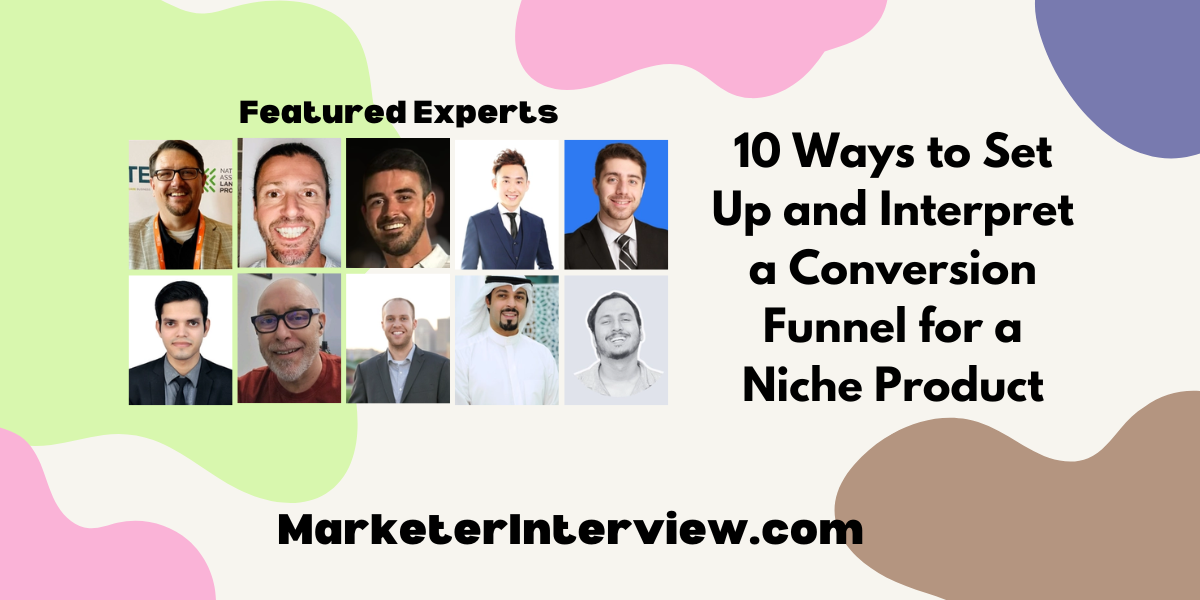10 Ways to Set Up and Interpret a Conversion Funnel for a Niche Product
Unlocking the secrets of a successful conversion funnel for niche products can be a game-changer, and who better to guide us than top CEOs and Directors? From implementing a customer feedback loop to personalizing content based on audience insights, discover the ten expert strategies provided by industry leaders to optimize your funnel’s performance.
Want to get quoted in MarketerInterview.com content just like this? Apply to become a contributor today!
Contents
- 1 Implement a Customer Feedback Loop
- 2 Understand Audience and Adjust Messaging
- 3 Focus on Initial and Final Touchpoints
- 4 Refine Stages with Detailed Analytics
- 5 Segment Audience for Tailored Funnel Stages
- 6 Map User Journey with Custom Event Tracking
- 7 Set Measurable Goals and Use Analytics
- 8 Monitor Stages and Analyze Key Metrics
- 9 Track Micro-Conversions for Engagement
- 10 Personalize Content Based on Audience Insights
Implement a Customer Feedback Loop
In setting up and interpreting a conversion funnel for a niche product, a “Customer Feedback Loop” strategy can be highly effective. Since niche markets are defined and specific, customers’ opinions and feedback have a high impact.
Implement stages in your funnel that actively seek out, collect, and analyze customer feedback. Use this data to optimize and reinforce the other stages of the funnel, making necessary tweaks for improvement. This closed-loop system of feedback creates a context where the customers themselves are contributing to optimizing the funnel, hence boosting conversions.

Abid Salahi, Co-Founder and CEO, FinlyWealth
Understand Audience and Adjust Messaging
Imagine a conversion funnel like a sieve for your sales process. Each stage filters out people until you’re left with happy customers at the bottom. For a niche product, it’s crucial to understand your audience deeply. Tip: Start by identifying where your potential customers hang out online or offline.
Then, craft tailored messages for each stage of the funnel, focusing on addressing their specific needs and concerns. Keep track of data at every stage to see what’s working and what needs tweaking. Remember, the goal is to guide people smoothly from being curious to becoming loyal fans of your niche product.

Srinath Pathak, Brand Manager, SarvaGram
Focus on Initial and Final Touchpoints
Setting up and interpreting a conversion funnel is essential for optimizing the customer journey, especially for niche products where targeted strategies can significantly impact results. Here is one best practice from my experience:
One best practice for conversion funnels, particularly with niche products, is to focus intensively on the initial and final touchpoints of your funnel. The first touchpoint, where you capture attention, should strongly resonate with the unique aspects of your niche market.
Use compelling storytelling and strong value propositions that speak directly to the niche’s needs and desires. For the final touchpoint, ensure your call to action (CTA) is clear, compelling, and easy to engage with.
In terms of analysis, monitor the drop-off rates at each stage but pay extra attention to the beginning and end of the funnel. High drop-offs at the start might indicate a messaging problem, while issues at the end could suggest checkout or commitment obstacles. Tailoring these touchpoints effectively can drastically improve the overall efficiency of your funnel.

Marc Bishop, Director, Wytlabs
Refine Stages with Detailed Analytics
For setting up and interpreting a conversion funnel for a niche product, it’s vital to deeply understand the customer journey. Focus on where the drop-offs occur and tailor the funnel stages to the unique behaviors of your target audience.
Use detailed analytics to refine each stage, ensuring messaging and incentives align closely with the specific needs and desires of your niche market. This approach transforms data into actionable insights, optimizing the path to conversion.

Ryan Doser, Co-Founder, AI Insider Tips
Segment Audience for Tailored Funnel Stages
One specific tip for setting up and interpreting a conversion funnel for a niche product is to clearly define and understand your target audience at each stage of the funnel. For niche products, where the target market might be smaller or more specific, it’s crucial to tailor each stage of the funnel to the unique needs and behaviors of this audience.
This involves segmenting your audience based on detailed criteria such as demographics, psychographics, and behavioral patterns, and then crafting messages and offers that are directly aligned with these segments.
For instance, in the awareness stage, use targeted advertising that speaks directly to the unique problems or desires your niche audience experiences, which your product can solve or fulfill. As they move to the consideration stage, provide detailed and highly specific content that addresses anticipated questions or concerns specific to your niche.
Finally, in the decision stage, utilize strong, tailored incentives that resonate specifically with your niche audience, such as exclusive memberships or specialized product bundles. This approach ensures that each part of the funnel is optimized for high conversion among your specific target audience, making the overall funnel more effective.

Shehar Yar, CEO, Software House
Map User Journey with Custom Event Tracking
To set up and interpret a conversion funnel for a niche product, and implement custom event tracking, you can map users’ exact journey toward conversion by defining specific events, such as button clicks or form submissions. This level of customization provides clear insights into where users drop off and which touchpoints drive engagement.
Use these insights to refine your marketing strategy, tweak the funnel, or enhance user experience. The key is to focus on the unique actions that lead to conversions in your niche, allowing you to optimize the funnel effectively.

Dhari Alabdulhadi, CTO and Founder, Ubuy New Zealand
Set Measurable Goals and Use Analytics
A specific tip for setting up and interpreting a conversion funnel for a niche product is to clearly define each stage of the customer journey and set specific, measurable goals for each step. Use analytics tools like Google Analytics to track how customers move through each stage, from awareness to purchase.
Focus on areas with the highest drop-off rates to identify and address barriers to conversion. This targeted approach helps optimize the funnel for better conversion rates and deeper insights into customer behavior.

Nicolas Krauss, Founder and CEO, dasFlow Custom Sublimation Apparel
Monitor Stages and Analyze Key Metrics
Closely monitoring and analyzing each stage of the conversion funnel is one effective tip for setting up and interpreting a conversion funnel for a niche product. By tracking key metrics and user behavior, businesses can identify potential bottlenecks and areas for improvement.
Utilizing analytics tools and implementing A/B testing can further optimize the conversion funnel, allowing businesses to make data-driven decisions and continuously improve the user journey. Regularly reviewing and analyzing the data enables businesses to identify trends, make informed adjustments, and maximize conversions for their niche product.

Travis Willis, Director of Customer Success, Aspire
Track Micro-Conversions for Engagement
Keep track of micro-conversions, such as newsletter sign-ups, social media follows, or time spent on specific pages, as a way to understand engagement and intent.
For a niche product such as bespoke jewelry, these micro-conversions can be as good a signal of interest as you are likely to get, and you can then nurture those leads accordingly.
If you focus on and optimize for those little actions, you’ll figure out where people are dropping off and what nudges or incentives you can give them to get them further down the funnel to the final purchase.

Mark McShane, Founder, Cupid Digital PR
Personalize Content Based on Audience Insights
In setting up a conversion funnel for a niche product, it’s essential to deeply understand your target audience. By tailoring each funnel stage with personalized content based on their pain points and behaviors, you can create a compelling buying journey.
When interpreting the funnel data, keep an eye on key metrics like conversion rates and drop-off points to identify and address any bottlenecks. Regularly reviewing these metrics and being open to new strategies will help optimize the funnel, improving user experience and boosting conversion rates.

Ace Zhuo, Business Development Director (Sales and Marketing), Tech and Finance Expert, Cheap Forex VPS
Want to get quoted in MarketerInterview.com content just like this? Apply to become a contributor today!






